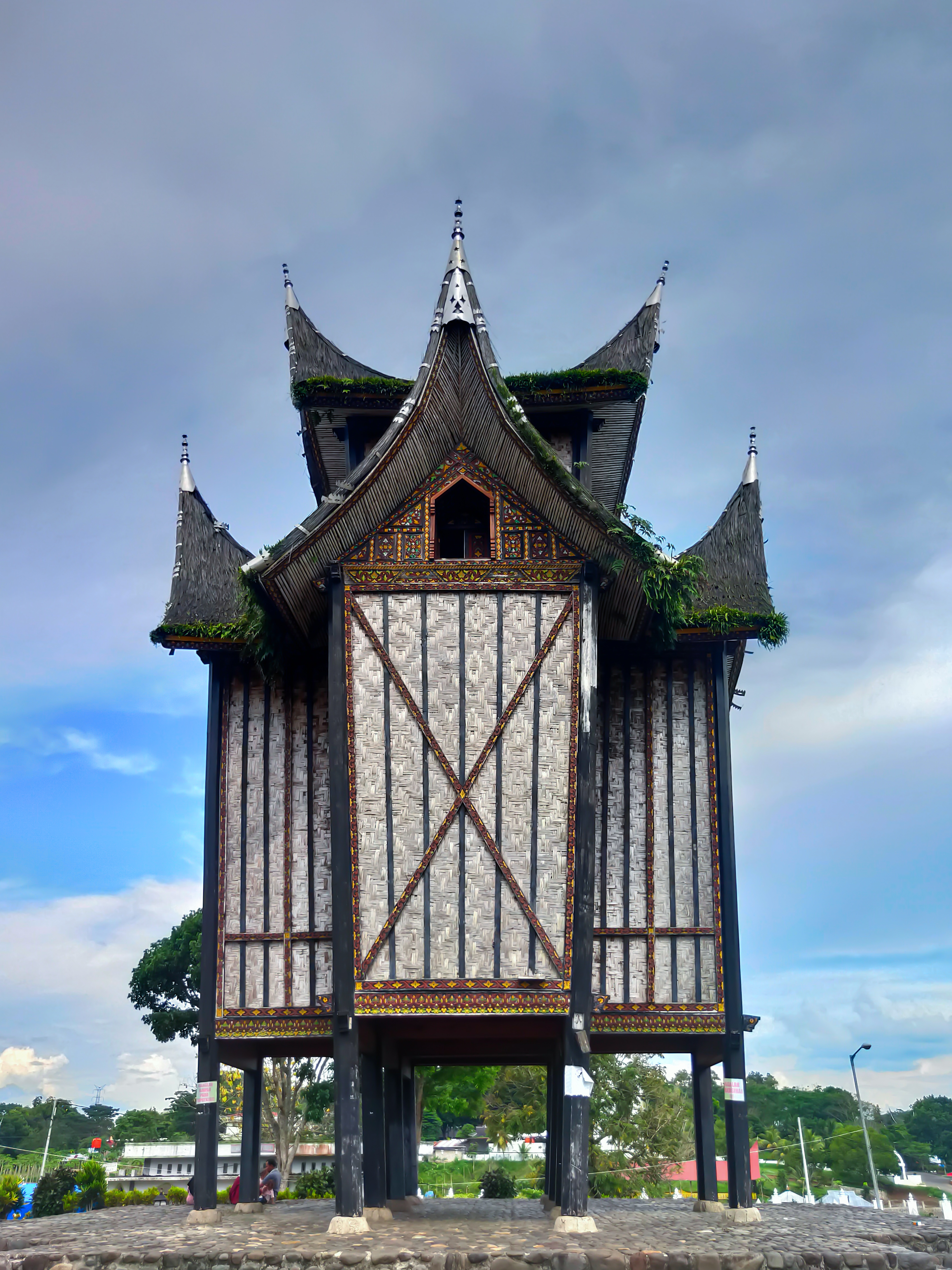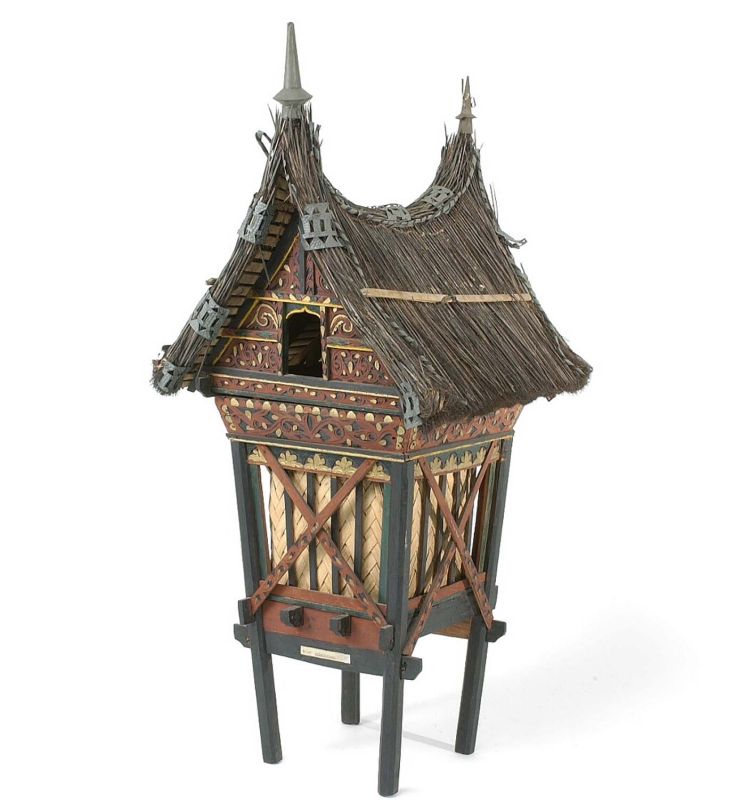Rangkiang on:
[Wikipedia]
[Google]
[Amazon]
 Rangkiang (also lumbuang) is a
Rangkiang (also lumbuang) is a
 Other ''rangkiang'', known as ''rangkiang kaciak'' ("little granary"), is used to keep rice seedlings (''padi abuan'') for agricultural purpose. This ''rangkiang'' used a simple gable roof instead of the elaborate Minangkabau roof form, thus it looks the simplest of all ''rangkiangs''.
The number of ''rangkiang'', as well as the degree of ornaments that decorates the ''rumah gadang'', shows the wealth of the owner. The more ''rangkiang'' possessed by a family, the more prestigious the owner is.
Other ''rangkiang'', known as ''rangkiang kaciak'' ("little granary"), is used to keep rice seedlings (''padi abuan'') for agricultural purpose. This ''rangkiang'' used a simple gable roof instead of the elaborate Minangkabau roof form, thus it looks the simplest of all ''rangkiangs''.
The number of ''rangkiang'', as well as the degree of ornaments that decorates the ''rumah gadang'', shows the wealth of the owner. The more ''rangkiang'' possessed by a family, the more prestigious the owner is.
 Rangkiang (also lumbuang) is a
Rangkiang (also lumbuang) is a granary
A granary, also known as a grain house and historically as a granarium in Latin, is a post-harvest storage building primarily for grains or seeds. Granaries are typically built above the ground to prevent spoilage and protect the stored grains o ...
or rice barn that the Minangkabau people
Minangkabau people (; ; ) are an Austronesian people, Austronesian ethnic group native to the Minangkabau Highlands of West Sumatra, Western Sumatra region on the Indonesian island of Sumatra. The Minangkabau's West Sumatera homelands was th ...
used to keep rice in. The rangkiang is a distinctive feature of Minangkabau architecture. The structure is traditionally found in the courtyard of a '' rumah gadang'', the traditional house of Minangkabau people.
Etymology
The word ''rangkiang'' is a shortened version from the Minangkabau word ''"ruanghyang
''Hyang'' (Kawi language, Kawi, Sundanese language, Sundanese, Javanese language, Javanese, and Balinese language, Balinese) is a representation of the King of the gods, supreme being, in ancient Mythology of Indonesia, Java and Bali mythology. T ...
(Dewi Sri)"'' ("room of goddess (Dewi Sri
Dewi Sri or Shridevi ( Javanese: ꦢꦺꦮꦶꦱꦿꦶ, Balinese: , Dewi Sri, Sundanese: , Nyai Pohaci Sanghyang Asri) is the Javanese, Sundanese, and Balinese Hindu Goddess of rice and fertility, still widely worshiped on the islands of Ja ...
)"), the goddess of rice.
Architecture
A ''rangkiang'' is a structure built over a raised pile foundation, an Austronesian legacy that can be found anywhere else in Indonesia. It has a distinguished roof shape known as ''gonjong'' ("spired") roofs, similar to a Minangkabau traditional house, the ''rumah gadang''. The ''gonjong'' roof symbolically identifies it with buffalo horns. Similar to the ''rumah gadang'', the roof of a rangkiang is traditionally a thatched roof made of palm fibre (''ijuk''), and it is also similarly decorated. The only opening to a ''rangkiang'' is a small rectangular hatch high up in the gable end, into which the harvested rice is placed. A ladder is required to reach this hatch. A ''rangkiang'' is traditionally built on the courtyard of a ''rumah gadang''. There are three types of ''rangkiang''s according to its function. A ''rangkiang'' which is used to store rice that is to be consumed by the inhabitants of the house is known as ''si bayau-bayau''. This ''rangkiang'', the largest of all ''rangkiang'', is traditionally supported by a minimum of six poles; in the case of a royal palace —such as the ''rangkiang'' of thePagaruyung Palace
Pagaruyung Palace () is the '' istana'' (royal palace) of the former Pagaruyung Kingdom, located in Tanjung Emas subdistrict near Batusangkar town, Tanah Datar Regency, West Sumatra, Indonesia. It was built in the traditional Minangkabau Rumah ...
— it can be supported by as many as twelve poles. This ''rangkiang'' is traditionally located at the right end of a ''rumah gadang'' Other ''rangkiang'', known as ''rangkiang kaciak'' ("little granary"), is used to keep rice seedlings (''padi abuan'') for agricultural purpose. This ''rangkiang'' used a simple gable roof instead of the elaborate Minangkabau roof form, thus it looks the simplest of all ''rangkiangs''.
The number of ''rangkiang'', as well as the degree of ornaments that decorates the ''rumah gadang'', shows the wealth of the owner. The more ''rangkiang'' possessed by a family, the more prestigious the owner is.
Other ''rangkiang'', known as ''rangkiang kaciak'' ("little granary"), is used to keep rice seedlings (''padi abuan'') for agricultural purpose. This ''rangkiang'' used a simple gable roof instead of the elaborate Minangkabau roof form, thus it looks the simplest of all ''rangkiangs''.
The number of ''rangkiang'', as well as the degree of ornaments that decorates the ''rumah gadang'', shows the wealth of the owner. The more ''rangkiang'' possessed by a family, the more prestigious the owner is.
Modern use
A facade of a Minangkabau restaurant is sometimes decorated with a single ''gonjong'' roof which represents the roof of a ''rangkiang'' as a symbol of rice and food provision for people.See also
* Rice barn * Leuit * Rumah gadangReferences
Works cited
* * * * * *External links
* {{Indonesian architecture Rumah adat Granaries Minangkabau Architecture in Indonesia +